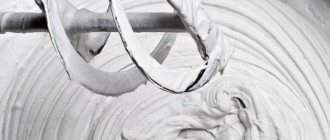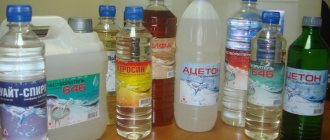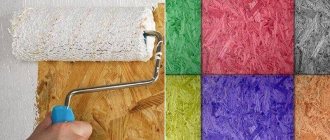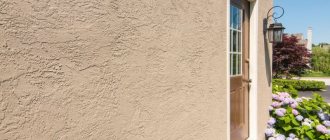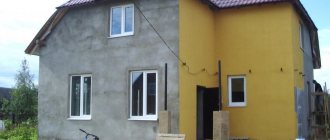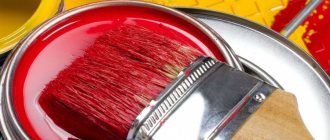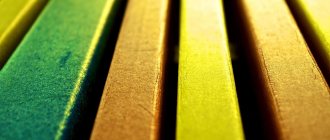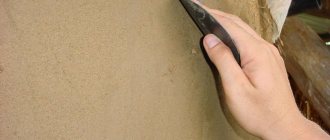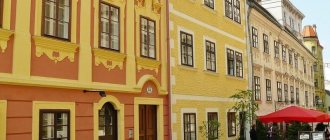Basic composition of plaster
Compared to other materials, it has low thermal conductivity. The basis of ordinary plaster is sand. Thermal insulation contains components that reduce its density and ensure the proper level of thermal insulation. The building material is based on binding components, the most common of which are gypsum, cement and lime.
The mixture is used for various purposes. Warm plaster for external use has a special composition: components are added to it that improve hygroscopicity. Gypsum and lime options are used for interior work. The universal product contains cement. Compositions of this type can be used for both exterior and interior decoration. Thermal insulating plaster for interior work, as well as a universal composition, are available in the form of powders. Before use they are diluted with water. Some builders prepare the bulk mixture themselves. However, it is recommended to purchase it from a reliable manufacturer.
Insulation is ensured due to the content of large additives in the product (they can be porous) and special fillers, which are most often used as sand, sawdust and glass.
Thermal insulating plaster includes water-repellent additives that release air. Antiseptic elements and plasticizers act as additional components. They are needed so that the mixture retains its properties.
Tests have shown: if the mixture is applied in a layer of 6 cm, thermal insulation will be provided as from two layers of brick. If winter is frosty, you should pay attention to this product. The mixture is applied to materials that allow cold to pass through. It can be used to seal gaps left after installing tiles.
What is thermal insulation plaster
The composition of warm plaster includes the following components:
- binder – Portland cement grade M400;
- a filler that creates pores in the volume of the material, reducing thermal conductivity and density;
- modifiers that increase workability, increase the “life” of the composition, and prevent cracking during drying and hardening.
Most manufacturers also add original plasticizers and water repellents of their own design. When making a solution at home, modifiers sold in stores, PVA glue, and detergents are added as additives.
In terms of adhesion to the surface of the walls, insulation under plaster is superior to cement-sand mixtures. Any suitable decorative coating can be applied to the surface.
Important! The use of warm plaster, due to the low volumetric weight of the material, reduces the load on the base.
Warm plaster based on polystyrene
Advantages and disadvantages
Warm plaster has a number of advantages:
- Ease of use. The building material is easy to use. The bulk mixture is simply diluted with water and applied to the cleaned surface.
- Good thermal insulation. The mixture is used to create an additional layer of insulation; it is used to level the walls.
- Ease. This building material is lighter than regular plaster.
- Strength. If used correctly, it will not crack.
- Resistance to temperature changes. The mixture can be applied in both hot and frosty weather, but when choosing, you should take into account the climate.
- Resistance to mold. This type of plaster is not covered with fungal spores.
- Versatility. It can be used as an additional soundproofing layer.
- Environmentally friendly. Most types of plaster are not harmful to health, but some, particularly those containing polystyrene, may be harmful.
Like any building material , the mixture has some disadvantages:
- Incomplete thermal insulation. If you need to comprehensively insulate a room, it is recommended to combine the mixture with special materials.
- It is applied only in a thin layer. If you need to apply a layer of 5-6 cm, you need to strengthen the foundation.
- High level of water absorption. This is a significant drawback, to eliminate which it will be necessary to perform additional finishing with waterproofing decorative materials.
- If you plan to create a thick layer of plaster (more than 2.5 cm), you need to make reinforcement using a metal mesh.
Price
Today you can find thermal insulation mixtures on sale, the price of which depends on the manufacturer. Here are some samples:
- warm plaster IVSIL (12 kg). A mixture based on cement with the addition of foam glass as a filler - 790 rubles;
- thermal insulation mixture KNAUF (25 kg). Cement-based composition with polystyrene foam filler – 347 rubles;
KNAUF(25 kg)
- WARMMIX plaster (14 KG). The mixture consists of cement, foam glass and polymer additives - 1950 rubles;
- KEM plaster (35 kg). Filler – perlite. Price – 295 rubles.
Filling options
Various elements are used in the composition of building materials.
- Sawdust. Sawdust plaster is practical. Cement and clay can be added to it. These materials are susceptible to the negative influence of the external environment, and therefore they are not intended for external decoration. A mixture with such elements will help insulate the house from the inside.
- Fine perlite. It forms air bubbles when the temperature rises. Thanks to them, it provides the proper level of thermal insulation. However, perlite has its drawbacks: when using it, waterproofing is required.
- Vermiculite. It has antiseptic properties and withstands temperature changes well and is resistant to fire. The component is universal. Mixtures in which it is present can be used for exterior and interior decoration. Despite the advantages, it will be necessary to create an additional layer of waterproofing.
- Foam glass balls . To get them, you need to foam quartz sand. Foam glass is often added to warm plaster. The advantages of the material are moisture resistance, good sound insulation. Plaster containing foam glass balls is used for interior and exterior decoration.
- Expanded clay chips. When using a composition with this component, additional waterproofing must be done. Mixtures with expanded clay chips are not in great demand.
- Expanded polystyrene. Thermal insulating plaster with this component is universal and affordable. However, it has a significant disadvantage - susceptibility to fire. When applied, it becomes soft, so additional processing is necessary.
Manufacturers and prices
The list of companies and the thermal insulation mixtures they produce is long. Popular ones:
- Umka UB-21 (Ecotermogroup company) is a warm plaster made of lime, cement, sand and foam glass for the northern regions, which requires finishing. With reinforcement, up to 10 cm is applied. Other insulating mixtures are UB-212, UF-2.
- Cement Knauf Grűnband is made with expanded polystyrene. The permissible layer is up to 30 mm.
- Unis Teplon has a gypsum-perlite composition that does not require finishing.
- Au Benputz Perlit based on Portland cement with perlite filler. You can't do without finishing.
- The Teplolux DeLuxe cement mixture retains heat using foam glass. It is also not final.
- Thermo Um is universal - used for facades and rooms. The mixture is hygroscopic.
Prices vary. On average, the price of 1 kg of dry mixture ranges from 11 to 21 rubles.
As practice shows, for the main areas of our country, heat-insulating plaster is not yet a panacea. However, its use allows not only to reduce heat loss, but also to reduce the noise level in the premises. For the southern regions, it is an excellent option for insulating houses.
Preparing the mixture
The mixture purchased at the store must be diluted with water according to the instructions. It is not recommended to use the entire composition at one time, as in this case it will not be possible to obtain the correct consistency. Mix the mixture thoroughly and leave for 4 minutes. During this time she will “ripen”. Experienced craftsmen prepare warm plaster in this way: take 4 kg of vermiculite and mix it with 1 kg of cement powder. The solution should be thick. After cooking, it is kept for 15 minutes.
No. 6. Making warm plaster with your own hands
Ready-made plaster is sold in powder form, which must be diluted with water. The proportions are indicated on the packaging. The main thing is to prepare the solution at once from all the powder in the package - it is not advisable to divide the mixture, since then it will be much more difficult to achieve the required consistency and, therefore, performance qualities. After thorough stirring, the mass is left to mature for 5 minutes, after which you can begin application.
You can save money and make warm plaster yourself . The most versatile and inexpensive solution is obtained using perlite or vermiculite. It is necessary to mix 4 parts of vermiculite or perlite and 1 part of dry cement. The thoroughly mixed mixture is diluted with a solution of water and a plasticizer. The latter can be purchased at the store, or can be replaced with PVA glue at the rate of 50-60 g of glue per 10 liters of plaster. The mixture is diluted with a water-adhesive composition and constantly stirred for homogeneity. The solution should have a thick consistency. After preparation, it is allowed to sit for 15-20 minutes, and you can begin applying the plaster.
The principle of applying building materials
First of all, you need to clean the surface, then prepare a solution of the correct consistency. The mixture is applied to a moistened surface, so it adheres better. The walls are plastered according to the lighthouses. As such, fixed metal profiles are used. To check the evenness, use a building level. If the composition is applied in a thick layer, a reinforcing mesh must be used.
A handful of the mixture is placed on a spatula , rubbed into the wall from top to bottom, then the surface is leveled. The composition retains plasticity for 2 hours, during which time unevenness can be corrected. Next, you need to remove the beacons, and use the same composition to grout the cracks. To level the surface, you can use a special grater. If several layers are required, the time interval between them should be 4 hours. The surface becomes dry after 2 days. After 48 hours, finishing is carried out.
Types of plasters for interior work
Even though the interior plaster is not visible after renovation, it is of great importance.
Finishing with interior plaster is an integral process of any construction.
It can be divided into two main types:
- wet (finishing with plaster mixtures);
- dry (finished with plasterboard).
Wet finishing is the most common and economical method , but it requires some experience. In other words, the quality of the surface depends on the skill of the performer. While the composition has not hardened, the surface can be corrected and subsequently refined with grout.
This type of finish can be used on any type of surface . Most often they use the manual method of applying the mixture, but for large areas it is more effective to use mechanisms.
Among the main functions are the following:
- surface preparation for finishing;
- increasing the sound, heat and moisture insulation properties of the room;
- protecting the wall from the negative effects of the environment;
- heat saving;
- decorative finishing.
Currently, the popularity of dry plasterboard finishing is increasing. This type of finishing has its advantages and disadvantages.
Popular manufacturing companies
The mixture of the Umka brand is universal. It is used to decorate walls outside and inside. Umka interacts with brick, concrete, and clay surfaces. The composition is applied manually or using a machine. The material contains basalt fiber. Some builders practice applying a layer of 10 cm.
The mixture is in demand because polystyrene foam and substances that provide protection from water are added to its composition. The maximum layer should be 2.5 cm.
The composition of the Mishka trademark contains foam glass filler. The advantage of the component is that it provides waterproofness and fire resistance.
The Houncliffe mixture is used as an additional layer of insulation. It contains components of our own production. "Houncliffe" is resistant to fire and moisture. When using this plaster, it is not necessary to apply a protective layer.
No. 4. Calculation of the thickness of the layer of warm plaster
To determine whether warm plaster can be used as an independent insulation material, you will have to perform a simple calculation, taking into account the region where the house is located, the thickness and material of the walls:
- calculation begins with determining the value normalized heat transfer resistance of the external walls of the house. This is a tabular value, predetermined by regulatory documents (for Russia - SNiP 02/23/2003). For Moscow, according to the table, this value is 3.28 m2*0С/W, for Krasnodar – 2.44 m2*0С/W;
Standardized heat transfer resistance for Russian cities
- define heat transfer resistance of house walls, for which we need to divide the wall thickness by the thermal conductivity coefficient of the material. Let's do the calculation for two houses. One is located in Moscow and is built of ceramic brick, the wall thickness is 0.5 m, the thermal conductivity coefficient from the table is 0.58 W/m0C, so the heat transfer resistance is 0.86 m2*0C/W. The second house is located in Krasnodar and is built from D600 foam block, wall thickness is 0.4 m, thermal conductivity coefficient from the table is 0.22 W/m0C, heat transfer resistance is 1.82 m2*0C/W;
Thermal conductivity coefficients of main wall materials
- calculation of additional insulation . For a house in Moscow this is (3.28-0.86) = 2.42 W/m0C. For a house in Krasnodar (2.44-1.82) = 0.62 W/m0C;
- calculation of a layer of warm plaster , its thermal conductivity coefficient is 0.063 W/m*0C (maybe a little more - depends on the composition and manufacturer). For a house in Moscow 0.063 * 2.42 = 0.15 m, for a house in Krasnodar 0.063 * 0.62 = 0.04 m. Since it is better not to apply warm plaster in a layer thicker than 5 cm, and it has a decent weight, then for a Moscow house it is better to look for another insulation option, and warm plaster can be used in addition. For a house in Krasnodar, warm plaster can be used as an independent insulation material.
A more accurate calculation can be made if we take into account the heat transfer resistance of all finishing wall materials, as well as take into account the number and size of windows and a host of other parameters. It’s easier to do this in special construction calculators, but you can understand whether warm plaster is worth considering as an independent insulation material from the above calculation.
Despite the manufacturer’s assurances and calculations proving the effectiveness of warm plaster, it is not very often used as the main insulation in residential buildings. It is usually used to insulate garages and cottages, and is used to eliminate cold bridges and to treat window and door openings. It is better to use insulation on the outside, but if this is not possible, it can also be applied inside so that it complements the external thermal insulation.
Advantages
To summarize, it should be mentioned that insulating mixtures have both advantages and disadvantages.
Among the main advantages it should be noted:
- fire safety;
- good degree of adhesion to all types of surfaces;
- environmental friendliness;
- thermal conductivity and sound and noise insulation;
- does not contain “cold bridges”;
- maintains indoor microclimate;
- no toxic emissions.
Working method
The temperature in the room where the work will be carried out should be from +5 to +25 degrees.
Preparing the base
The quality of the resulting surface depends on three main components: surface preparation, mixture composition and correct installation of beacons.
The surface is considered ready for use if:
- cleaned of dirt and grease stains;
- durable;
- there are no peelings of previous coatings.
It is advisable to pre-treat concrete surfaces with a primer.
Preparation of the solution
For the finished mixture, follow the proportions and stirring time specified in the instructions.
Please pay attention to the following tips:
- the mixture should not contain lumps. To improve consolidation, it is recommended to use a construction mixer;
- in order to check its readiness, you need to put it on a trowel and turn it over. A solution of normal consistency will not flow or fall off.
Application of the solution and finishing work
Working with insulating plaster is not much different from working with other types of mixtures.
The order of work is as follows:
- to obtain a flat surface, beacons should be installed;
- unlike other mixtures, the solution is not poured on, but rubbed into the surface with a spatula or trowel;
- remove beacons;
- smooth with a grater or rule.
If you need to apply several layers, you should take breaks of at least 4 hours. In rooms with high humidity or low temperatures, it is recommended to increase the intervals between application of layers. Maximum strength is achieved after 28 days. The maximum thermal insulation value will be reached after 60 days. Subsequent finishing can begin after 48 hours.

